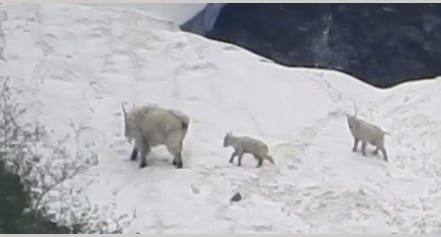We pulled onto the wide shoulder beside the viewpoint for Barronette Peak, an eroded wall of a mountain on the other side of Soda Butte Creek. Folks were meandering back to their vehicles. While buttoning up my plaid shirt against the cool breeze, I stopped a tall, thin, white man carrying a large camera lens on a tripod and asked, “what did you see?”
He directed my gaze towards a patch of snow shaped like an apostrophe, high above the river valley. I found the spot and brought the camera to my eye. As much as I’d like to wean myself from viewing the world through a lens, it comes in handy as a telescope. And when I found the location, I was able to record the nanny with two kids traversing the snow patch.
Some Background
Mountain goats are neither a goat nor a native to the Yellowstone ecosystem. These creatures are actually in a group all their own. They’re very similar to goats, but their scientific name, Oreamnos americanus, shows us they’re in a different genus. (Goats and their relations are in the genus Capra.)
Based on various pieces of evidence, scientists believe that the mountain goats arrived in North America via the land bridge sometime during the late Miocene (5 – 23 million years ago). The interior was glaciated at that time, so these critters would’ve stuck to the coastal and coastal-adjacent mountain ranges. Prior to human intervention, mountain goats were found only in the mountainous regions of northwestern North America, from southeastern Alaska and the southern Yukon to the Columbia River in Washington, and east into Idaho and western Montana – but only on the west side of the Continental Divide.
From about the 1920’s to the 1950’s, hunting groups introduced mountain goats into regions they’d never been before, like Olympic National Park, the Colorado Rockies, and the range we’re looking at here – the Absarokas. While this gives us more large mammals to look at while we visit different parks, the presence of these non-native grazers in sensitive alpine habitats creates a management nightmare.
Alpine habitats are considered sensitive because the harsh growing conditions do not allow plants to recuperate from impacts fast enough to preserve the habitat. For example, if a mountain goat grazes the plants down to their roots, the growing season isn’t long enough for those plants to rebound before the land is covered with snow again. This means the roots don’t get the nutrition they need to survive the winter, and the next year you’ve got bare soil. That bare soil, with nothing to hold it in place, more easily washes away with the melting snow and rainfall of spring.
Mountain goat grazing also means there’s fewer plants for other, native, animals who rely on the same food source.
It is a conundrum, putting land managers in a tough position, having to balance positive sentiment towards the animals with the damage they have on the ecosystem. At Olympic National Park, in accordance with their exotic species management plan, about 400 animals were removed between 1981 and 1989. They population rebounded and in 2018 the Mountain Goat Management Plan was finalized and put into action. The goal: complete removal. The first 325 goats were relocated to the Cascade Range, where mountain goats are native. Since then, about 300 more animals have been lethally removed.
Yellowstone National Park doesn’t appear to have a plan or policy on mountain goat removal at this time. Their neighbor, Grand Teton National Park, has a removal plan in place to help protect their native bighorn sheep and the fragile alpine ecosystem.
Caught Between Awe and Impact
It’s easy to ponder lethal removal in the abstract – too many animals, destroying habitat? Yes, we need to protect what belongs there. Then you look at the individuals, like this family unit. You watch them, and you begin to notice that they have very real lives, happening independent of our presence and influence. They didn’t choose to be in this environment and they’re not out to destroy it. Like most living beings, they are simply trying to exist, and maybe have a little fun in the process:
I loved seeing mountain goats in Yellowstone. Just like other large wildlife sightings, they add something to the landscape with their presence – a sense of wildness, of a world untamed. And these animals, walking on the edge of precipices hundreds of feet above the earth as if it was nothing but flat ground beneath them, are particularly inspirational. What feels like the utmost bravery to me is just another Tuesday for them. The world they live in is literally precipitous, yet they survive and thrive and even play along the way. I’m grateful to have gotten to witness them living their lives, especially this precocious little kid running off to do a little sledding.







